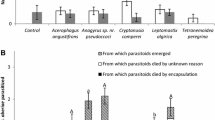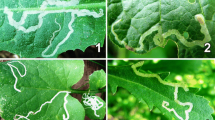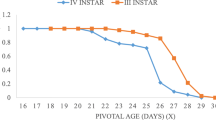Abstract
The ovipositional response of deutogynes of the pear rust mite, Epitrimerus pyri Nalepa, and the rate of development of E. pyri nymphs differed according to the host plant to which mites were exposed. Among the fourteen Pyrus hosts examined, leaves from the Clapp's Favorite cultivar of P. communis elicited the strongest egg-laying response and the fastest rate of nymphal development, whereas egg-laying was least and nymphal development slowest on leaves from P. calleryana. Among the three non-Pyrus hosts, E. pyri oviposited and completed nymphal development on apple and quince leaves, but would not deposit eggs on apricot. Antixenosis appears to be the primary mechanism of resistance, although antibiosis may be operating to a lesser extent. These results are discussed in relation to the resistance of Pyrus to other arthropod pests.
Similar content being viewed by others
References
Albrigo L.G., McCoy C.W. and Tucker D.P.H., 1987. Observations of cultural problems with the ‘Sunburst’ mandarin. Proc. Fla. State Hort. Soc., 100: 115–118.
Anderson M.M., 1971. Resistance to gall mite (Phytoptus ribis Nal.) in the Eucoreosma section of Ribes. Euphytica, 20: 422–426.
Butt B.A., Stuart L.C. and Bell R.L., 1988. Feeding behavior of pear psylla (Homoptera: Psyllidae) nymphs on susceptible and resistant Pyrus germplasm. J. Econ. Entomol., 81: 1394–1397.
Butt B.A., Stuart L.C. and Bell R.L., 1989. Feeding, longevity, and development of pear psylla (Homoptera: Psyllidae) nymphs on resistant and susceptible genotypes. J. Econ. Entomol., 82: 458–461.
Chang J.F. and Philogene B.J.R., 1976. The development and behaviour of the pear psylla, Psylla pyricola, (Homoptera: Psyllidae) on different pear rootstocks and cultivars. Phytoprotection, 57: 137–149
Connin R.V., 1956. The host range of the wheat curl mite, vector of wheat streak-mosaic. J. Econ. Entomol., 49: 1–4.
Das G.M. and Sengupta N., 1958. Observations on the pink mite, Acaphylla theae (Watt) Keifer, of tea in north-east India. J. Zool. Soc. India. 10: 39–48.
Das G.M. and Sengupta N., 1962. Biology and control of the purple mite, Calacarus carinatus (Green), a pest of tea in north-east India. J. Zool. Soc. India. 14: 64–72.
Easterbrook M.A., 1978. The life-history and bionomics of Epitrimerus pyri (Acarina: Eriophyidae) on pear. Ann. appl. Biol., 88: 13–22.
Easterbrook M.A., 1979. The life-history of the eriophyid mite Aculus schlechtendali on apple in south-east England. Ann. appl. Biol., 91: 287–296.
Gibson R.W., 1974. Studies on the feeding behaviour of the eriophyid mite Abacarus hystrix, a vector of grass viruses. Ann. appl. Biol., 78: 213–217.
Harris M.K., 1973. Host resistance to the pear psylla in a Pyrus communis x P. usseriensis hybrid. Environ. Entomol., 2: 883–887.
Harris M.K., 1975. Greenhouse testing of pears with Pyrus usseriensis lineage for resistance to Psylla pyricola. J. Econ. Entomol., 68: 641–644.
Harvey T.L. and Seifers D.L., 1991. Transmission of wheat streak mosaic virus to sorghum by the wheat curl mite (Acari: Eriophyidae). J. Kansas Ent. Soc. 64: 18–22.
Harvey T.L. and Martin T.J. 1990. Resistance to Russian wheat aphid, Diuraphis noxia, in wheat. Cereal Res. Commun., 18: 127–129.
Harvey T.L. and Martin T.J. 1992. Resistance to the wheat curl mite (Acari: Eriophyidae) in common wheat. Cereal Res. Commun., 20: 63–66.
Herbert H.J., 1974. Notes on the biology of the apple rust mite, Aculus schlechtendali (Prostigmata: Eriophyoidae), and its density on several cultivars of apple in Nova Scotia. Can. Ent., 106: 1035–1038.
Herr R., 1991. Investigations on resistance of Ribes against the black currant gall mite Cecidophyopsis ribis (Westw.) (Acari: Eriophyidae). Bioassays in the laboratory and infestation experiments in the field. J. Appl. Ent., 112: 181–193.
Jeppson L.R., Keifer H.H. and Baker E.W., 1975. Mites injurious to economic plants. University of California Press, Berkeley.
Keifer H.H., 1952. The eriophyid mites of California (Acarina: Eriophyidae). Bulletin of the California Insect Survey 2: 1–123.
Knight R.L., Keep E., Briggs J.B. and Parker J.H., 1974. Transference of resistance to black-currant gall mite, Cecidophyopsis ribes, from gooseberry to black currant. Ann. appl. Biol., 76: 123–130.
Layne R.E.C. and Quamme H.A., 1975. Pears. In: JulesJanick and James N. Moore (Editors), Advances in Fruit Breeding. Purdue University Press, West Lafayette, pp. 38–70.
Nault L.R. and W.E.Styer 1969. The dispersal of Aceria tulipae and three other grass- infesting eriophyid mites in Ohio. Ann. Entomol. Soc. Am., 62: 1446–1455.
Pavlova N.M., 1963. Research work on fruits and berries in 1959–1960. Trudy po Prikladnoi Botanike, Genetike i Selektsii, 33: 196–206.
Pavlova N.M., 1964. Possibilities of breeding black currant varieties resistant to the bud gall mite. Trudy po Prikladnoi Botanike, Genetike i Selektsii, 36: 94–102.
Pavlova N.M., 1969. The best introduced black currant varieties from the collection of the Institute of Plant Industry and their use by breeders. Trudy po Prikladnoi Botanike, Genetike i Selektsii, 40: 130–139.
Quamme H.A., 1984. Observations of psylla resistance among several pear cultivars and species. Fruit Var. J., 38: 43–36.
Rice R.E. and Strong F.E., 1962. Bionomics of the tomato russet mite, Vasates lycopersici (Massee). Ann. Ent. Soc. Am., 55: 431–435.
SAS Institute, 1985. SAS User's Guide: Statistics, Version 5. SAS Institute, Inc., Cary, N.C.
Westigard P.H., Westwood M.N., and Lombard P.B., 1970. Host preference and resistance of Pyrus species to the pear psylla, Psylla pyricola Foerster. J. Amer. Soc. Hort. Sci., 95: 34–36.
Westwood M.N. and Westigard P.H., 1969. Degree of resistance among pear species to the woolly pear aphid, Eriosoma pyricola. J. Amer. Soc. Hort. Sci., 94: 91–93.
Yothers, W.W., and Mason, A.C., 1930. The citrus rust mite and its control. UDSA Tech. Bull. 176.
Zar J.H., 1984. Biostatistical Analysis. second edition. Prentice-Hall, Inc., Englewood Cliffs, N.J.
Author information
Authors and Affiliations
Rights and permissions
About this article
Cite this article
Bergh, J.C., Weiss, C.R. Pear rust mite, Epitrimerus pyri (Acari: Eriophyidae) oviposition and nymphal development on Pyrus and non-Pyrus hosts. Exp Appl Acarol 17, 215–224 (1993). https://doi.org/10.1007/BF00118438
Accepted:
Issue Date:
DOI: https://doi.org/10.1007/BF00118438




